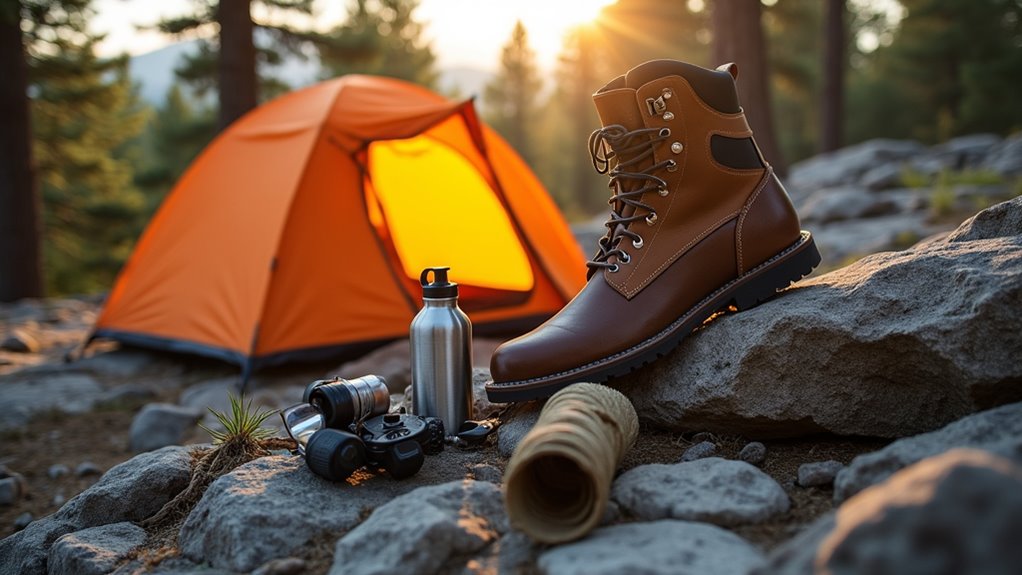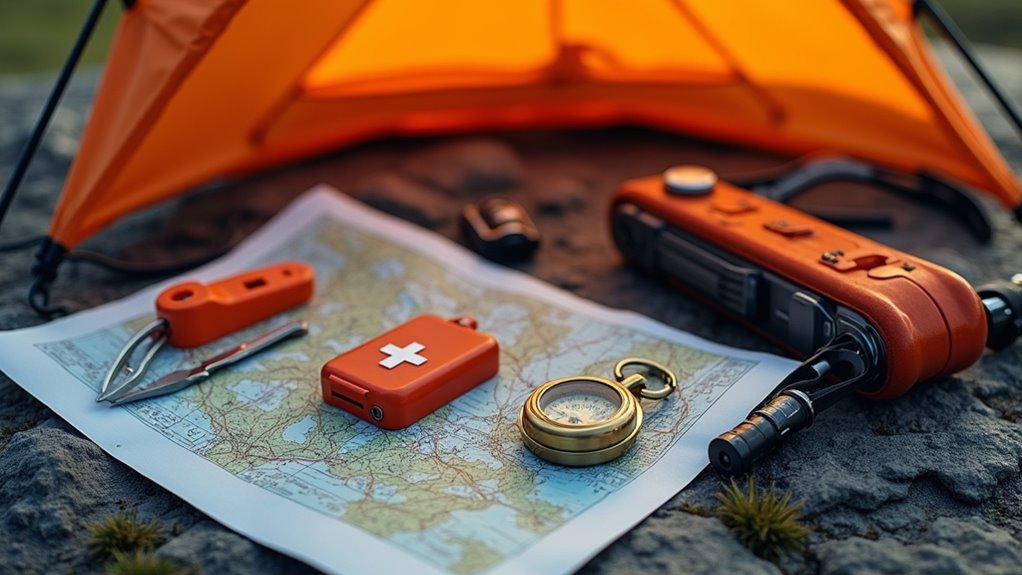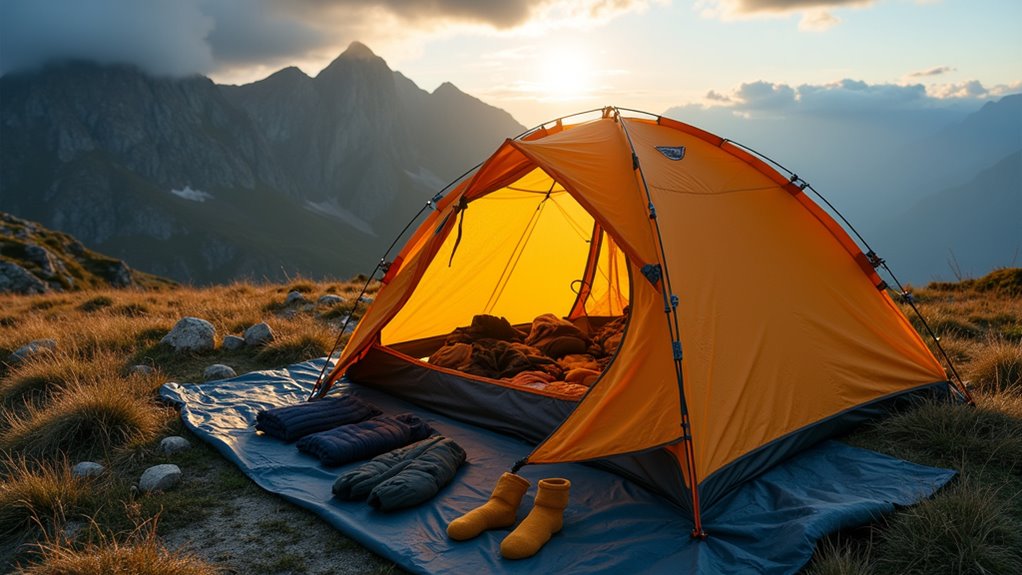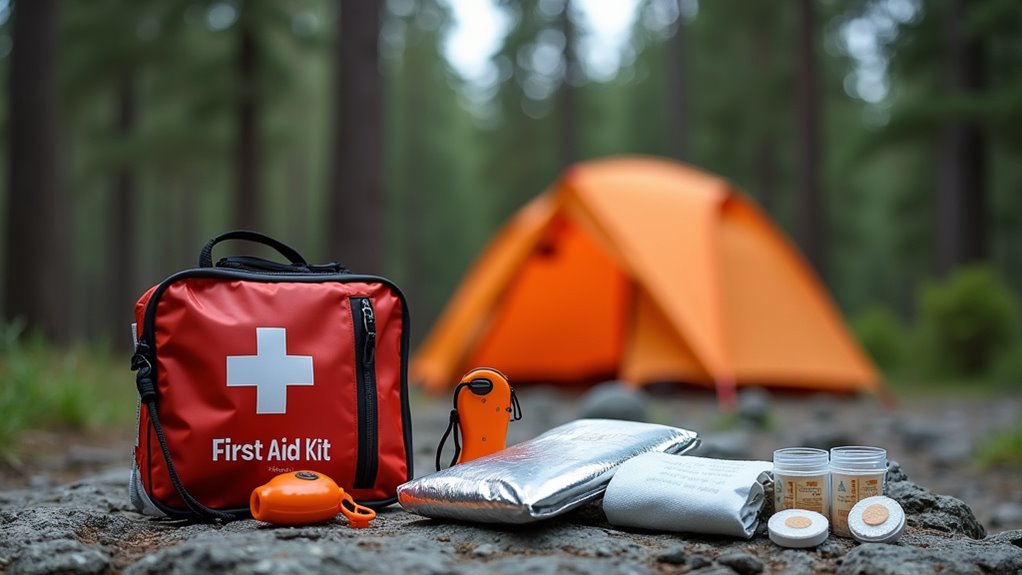Physical Address
304 North Cardinal St.
Dorchester Center, MA 02124
Physical Address
304 North Cardinal St.
Dorchester Center, MA 02124

Hiking with tents requires careful gear selection beyond just shelter—discover which essential items separate successful adventures from dangerous disasters.
When you’re planning a backcountry hiking trip with your tent, you’ll quickly realize that what you don’t pack can make or break your adventure. While your shelter’s obviously vital, it’s just one piece of a much larger puzzle that includes navigation tools, cooking gear, weather protection, and emergency supplies. The key isn’t bringing everything you own—it’s selecting the right essentials that’ll keep you safe, fed, and comfortable without destroying your budget or your back.

When you’re heading into the backcountry, your safety equipment isn’t just gear—it’s your lifeline when things go wrong. You’ll need a reliable map and compass as your primary navigation tools—GPS devices can fail, but these won’t.
Pack a whistle for emergency signaling and a headlamp with extra batteries for hands-free lighting. Don’t forget a basic first aid kit with bandages, pain relievers, and any personal medications.
A multi-tool covers countless scenarios, while emergency shelter like a space blanket costs under five dollars but could save your life. Fire-starting materials should include waterproof matches and a lighter.
Finally, carry enough water purification tablets or a portable filter—dehydration kills faster than most other backcountry dangers you’ll face. Before you pack, consider your camping style preferences to ensure you bring the right gear for your specific adventure.
After covering safety gear, let’s talk about keeping yourself fed during those longer adventures. You’ll need a lightweight camping stove and fuel canister – single-burner models work great for most trips. Pack a compact pot set with a lid that doubles as a plate. Don’t forget a lightweight spork and a sharp knife.
For food storage, bear canisters are required in many areas, though they’re pricey. Alternatively, use odor-proof bags and hang your food properly. Pack calorie-dense foods like nuts, dried fruits, and instant meals that rehydrate easily.
Bring a collapsible water container and purification tablets or a lightweight filter.
Clean water is essential for any backcountry trip, so pack portable purification methods and extra storage capacity.
You’ll save money buying generic camping meals instead of brand names, and they’ll fuel your adventures just as well.

While your tent provides shelter at night, you’ll need proper clothing layers to handle weather changes throughout your hiking day. Start with moisture-wicking base layers that pull sweat away from your skin.
Add an insulating mid-layer like fleece or down that you can easily remove when you warm up. Top it off with a waterproof shell jacket for rain and wind protection.
Don’t forget essential accessories: a warm hat, waterproof gloves, and extra socks. Pack a lightweight rain poncho as backup – it doubles as ground cover.
Choose merino wool or synthetic materials over cotton, which stays wet and loses insulation. Budget-friendly options include thrift store fleece and discount outdoor retailers.
Always pack one extra layer beyond what weather forecasts predict. Just like deciding whether to rent or buy outdoor gear, consider how often you’ll use specialized hiking equipment before making expensive purchases.
Though your tent forms the foundation of your outdoor shelter, a complete sleep system requires three essential components working together: your sleeping bag, sleeping pad, and pillow setup.
Your sleeping bag’s temperature rating should match expected nighttime lows, plus add a 10-degree buffer for safety. Down bags offer superior warmth-to-weight ratios but lose insulation when wet, while synthetic fills perform better in damp conditions and cost less.
Don’t skimp on your sleeping pad—it’s vital for insulation from cold ground. R-values indicate thermal resistance; aim for R-3 to R-5 for three-season camping.
For pillows, you’ve got options: inflatable pillows pack smallest, stuff sacks filled with clothes work free, or simply use extra clothing.
Test your complete system at home before hitting the trail. These seven essential camping items form the foundation of quality outdoor sleep, ensuring you wake up refreshed and ready for your next day’s adventure.

Remote hiking locations can leave you hours or even days away from medical help, making a well-stocked first aid kit your safety lifeline. Don’t skimp on these essentials – they’re worth every ounce in your pack.
Your emergency kit should include:
Add blister treatment patches and elastic bandages for common hiking injuries. Store everything in a waterproof container and check expiration dates before each trip.
For those following plant-based diets, pack extra vegan-friendly energy bars and snacks to maintain proper nutrition during extended outdoor adventures.
Knowledge matters too – consider taking a wilderness first aid course.
Picture yourself confidently traversing that rugged mountain trail, your pack loaded with smart essentials that won’t break the bank. You’ve got your navigation tools, safety gear, and weather protection working together like a well-oiled machine. When storm clouds gather or fatigue sets in, you’ll be grateful for every thoughtful item you’ve packed. Don’t cut corners on the basics—your safety depends on preparation, and your wallet doesn’t have to suffer for quality gear.